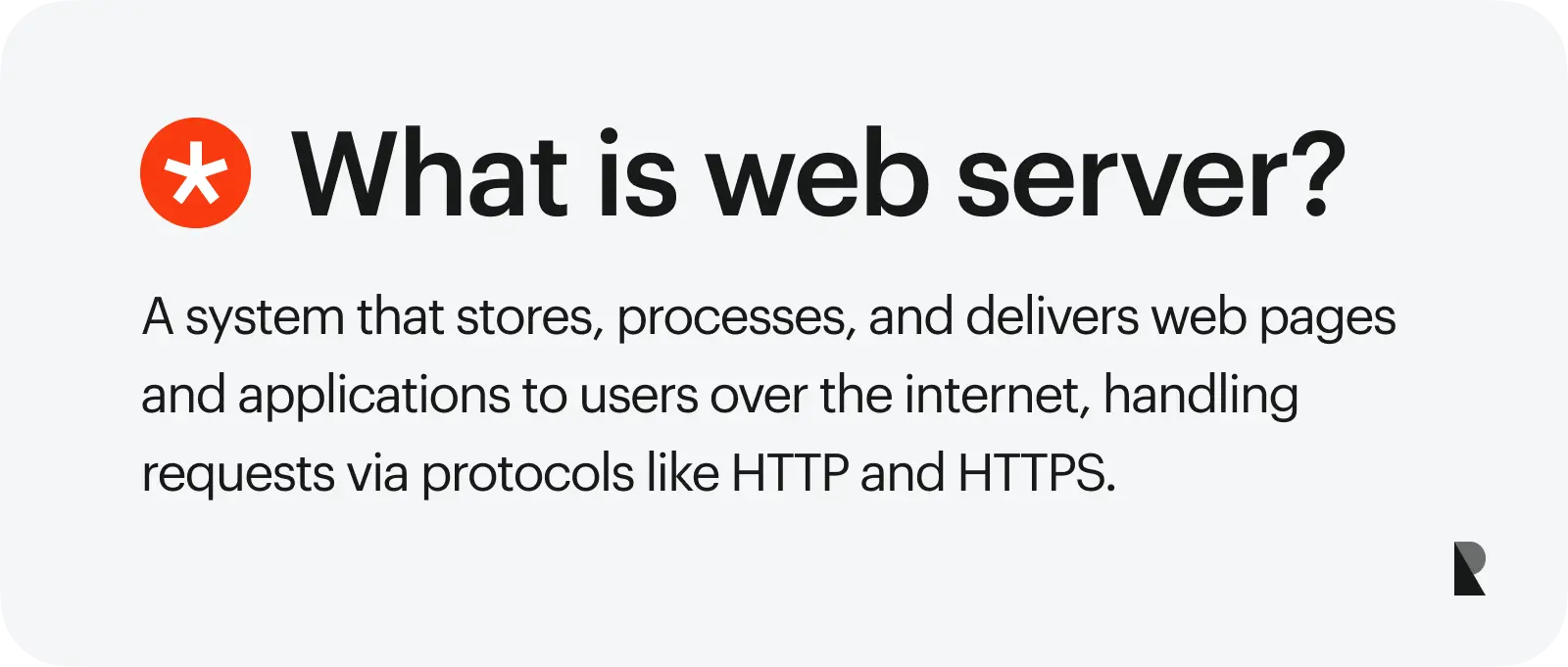
Web development is a complex process. Hence, businesses usually rely on a web development agency to establish their online presence.
While it gets the job done faster and better, it is always important to know the basics. You can maximize your benefits once you understand how your web server functions.
Businesses need to optimize the use of their web applications. It ensures that their digital presence is noticeable and contributes to their growth. Since web servers are the basis of managing your web content and platform, we can start exploring the basics there.
In this article, we will understand a web server and its role in the entire web development process. We will also explore some popular web server options and how choosing the right one can ensure data security for your business.
Read along to learn all about a web server and its many capabilities that can benefit your enterprise.
Introduction
Web applications become the online face of any business. Hence, it is essential to create web browsers that ensure an interactive interface for the users and offer an enhanced user experience. In digital presence of businesses, creativity is essential to gain attention.
Companies either have complete in-house development teams or hire one of web development agencies to maintain their web presence. While this task is suited for developers and experts in the field, a basic understanding of the process allows enterprises to formulate better plans to utilize a website's resources.
Whenever you use a web browser, you interact with a web server working at the backend to present you with the final webpage. Let’s examine the role of web servers and their capabilities to enhance an organization’s digital presence.
Defining Web Server
While a traditional understanding of web servers is considered hardware located in data centers, the actual term consists of hardware and software components. The term web server refers to an entire system that syncs to deliver web content to your device.
The hardware component of a web server includes the physical computer system on which the website files are stored. It comprises HTML documents, videos, and images. The hardware system is mostly connected to cloud storage via the Internet and has a huge storage capacity.
What is a web server?
A web server is a program that consists of hardware and software components that work together to process network requests from users to access different web pages on their browsers.
The other component is the web server software. It consists of application servers that manage and run the website files on the hardware components. Hence, it controls the communication between the hardware component of a web server and the browser accessing the website.
These application servers primarily use the Hypertext Transfer Protocol (HTTP) to communicate with a web browser. Other protocols used by a web server include Simple Mail Transfer Protocol (SMTP) and File Transfer Protocol (FTP) for email, file transfer, and storage.
Any device used to access websites online must have web server software to enable its connection with application servers that process requests via data stored on hardware components. Hence, web browsers become gateways to different web pages online using web servers.
How do web servers work?
Web and application servers interact and work in a client-server model where the client refers to the entity requesting access to a web page while the server provides it. The process uses an HTTP protocol to respond to requests made via the World Wide Web. It enables computers to exchange information using their web browsers.
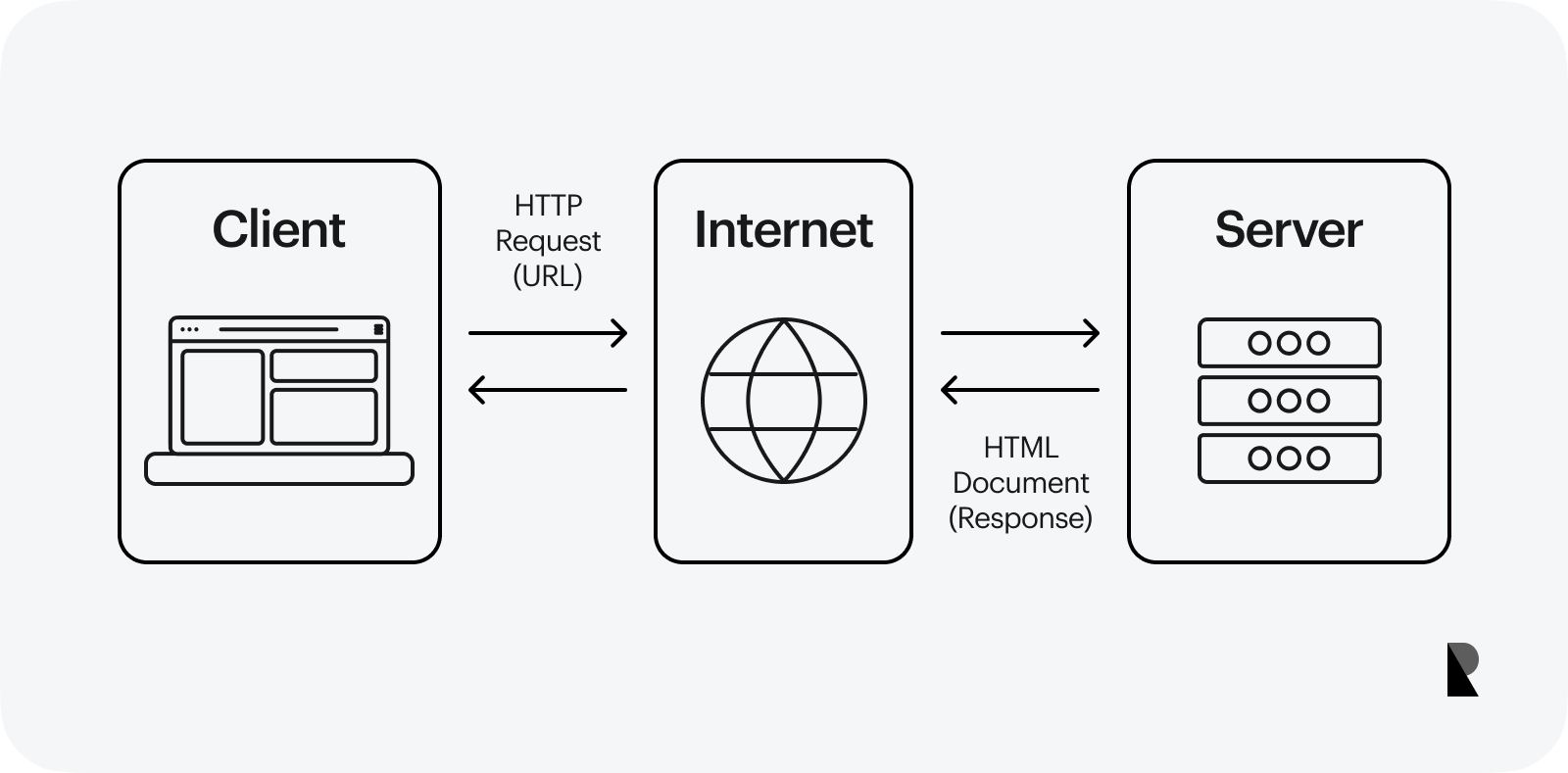
A web server processes requests between client and server
The entire process of how web servers work can be broken down into the following steps:
Request and address
The process is initiated when you type a URL into your web browser. The browser processes the entered information to find the physical location of the requester's web server where its relevant files are stored. Hence, the first step involves requesting a site and using the browser to look up its address.
Details of the web browser’s search
The search for the requested web server begins by converting the web address into an IP address using a Domain Name System (DNS). Since the IP address is a unique numerical number assigned to every device on the Internet, locating the IP identifies the application servers to which the request must be sent.
Request received at the web server software
A web browser uses an HTTP server to request access to the relevant web server software. The request received at the source web server contains information about the specific web page that needs to be accessed.
Searching for the requested files
The web server software searches the stored files at its end to find the requested ones. These files can range from HTML documents and images to programs that create dynamic web content.
Respond to the request
Once the server software's search is complete, the information is communicated back to the browser using an HTTP server. Your web browser will show you the relevant result if the files were found by the server.
If the files are not found, the browser displays the error message 404 Not Found. Apart from these, a 403 error can also be displayed if there are permission issues.
Hence, the above process is executed whenever you type in a URL in your web browser to get the relevant information from the source web. HTTP servers are designated messengers that get the requested information from the end web to the front end for display.
What are web servers used for?
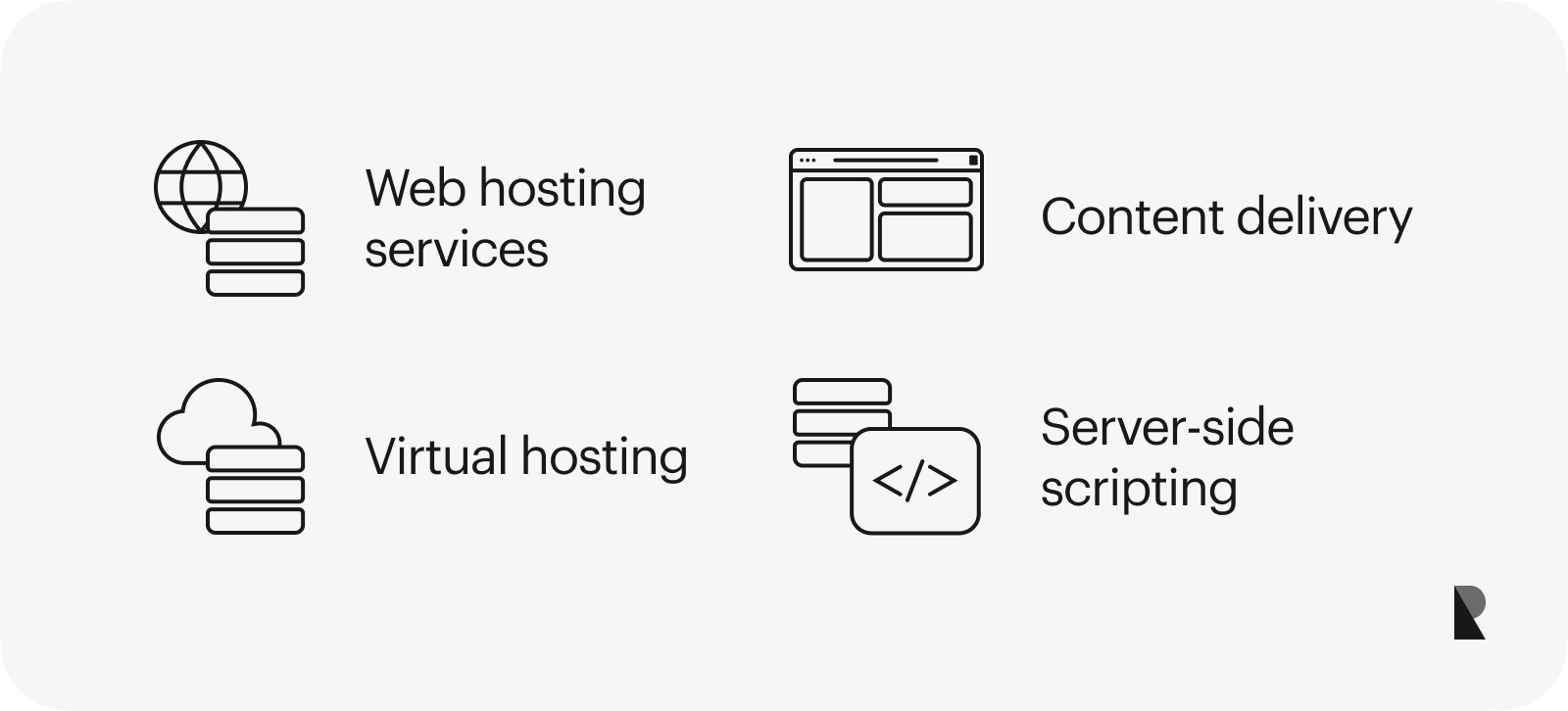
Web servers are crucial in the valuable existence of the internet and the execution of web services. The entire communication channel between clients and backend servers is only possible through the work of web servers. Let’s look at some of the significant uses of a web server.
Web hosting services
It refers to accessing a web server for your website’s database management. The servers use space to store the data files that make up your website. Companies purchase web hosting and a domain name to designate some space on the server for their hosted files.
Web hosting services configure the server to make websites accessible by assigning them unique IP addresses. This service management also links these IPs to URLs using DNS. It allows enterprises to effectively manage and scale their website's management products, including storage, bandwidth, scalability, and security.
Virtual hosting
An additional aspect of web hosting is virtual hosting. It enables a single physical server to host and manage multiple websites, offering improved resource utilization and cost-effectiveness.
Some common forms of virtual hosting include:
- IP-based - each website has a unique IP address
- Name-based - each website owns a particular domain name
- Port-based - each website is assigned a specific port number on the server
Hence, multiple methods are used to identify websites virtually hosted on the same server. The network traffic is segregated and processed according to the differentiating indicators. This is beneficial for businesses as it is more cost-effective than using a dedicated server.
Content delivery
While a web server stores your website’s data and information, it also plays a critical role in delivering relevant content when needed. Hence, content delivery is an essential use of web servers. They make it possible for information on web pages from the server side to be accessed by the client side as requested.
The application servers constantly receive, process, and complete incoming requests, ensuring optimized content delivery with faster loading times to the end user. The servers work to provide a smooth user experience for any company’s customers when accessing their website.
Server-side scripting
It is a technique used in web development to create dynamic web content. In this process, the application servers do not simply share the HTML file against the requested code.
Instead, they process the request using a scripting language to generate specialized HTML code that aligns better with the requested information. Also it enables businesses to create more personalized experiences for their users.
Hence, each customer gets access to a specialized web page that is designed and developed at the backend according to their particular interests and preferences. This results in enhanced personalization and user experience.
Web servers manage the backend operating system that ensures the smooth running of websites on the Internet. They are crucial tools for businesses to stay relevant and connected with their market and customers.
Web server capabilities
Whhile users access the digital platform for every query and answer, web application servers play a vital role in finding the right answers. They are crucial in connecting the relevant website data to the end users.
An application server stores and manages data for users to access as needed. Servers also use hybrid cloud environments for web server management, including traffic management, optimized resource allocation, and data security.
It allows web servers to communicate with web browsers to share information via HTTP protocols in a secure environment. Side scripting ensures the generation of dynamic content for web pages, contributing largely to enhanced user experiences.
These capabilities make using an application server important for managing web pages. Let’s explore the different configuration methods for optimal performance.
- Performance tuning identifies any bottlenecks in the server logs and makes adjustments to optimize resource allocation and improve response times.
- Security measures: These consist of regular security updates, firewalls, and access control lists to protect the server from external malicious attacks.
- Caching: It enables the server to store frequently accessed files to reduce server load and improve loading time for web pages
- Load-balancing: it distributes traffic across multiple web servers, preventing overloading and smooth operation during high-traffic
These are some of the techniques employed by web development teams to ensure the smooth operation and optimized utilization of application servers.
Differences between a web server and an application server
Both tools deliver content online and maintain an optimized user experience. Before we explore the basic differences between them, let’s understand them better.
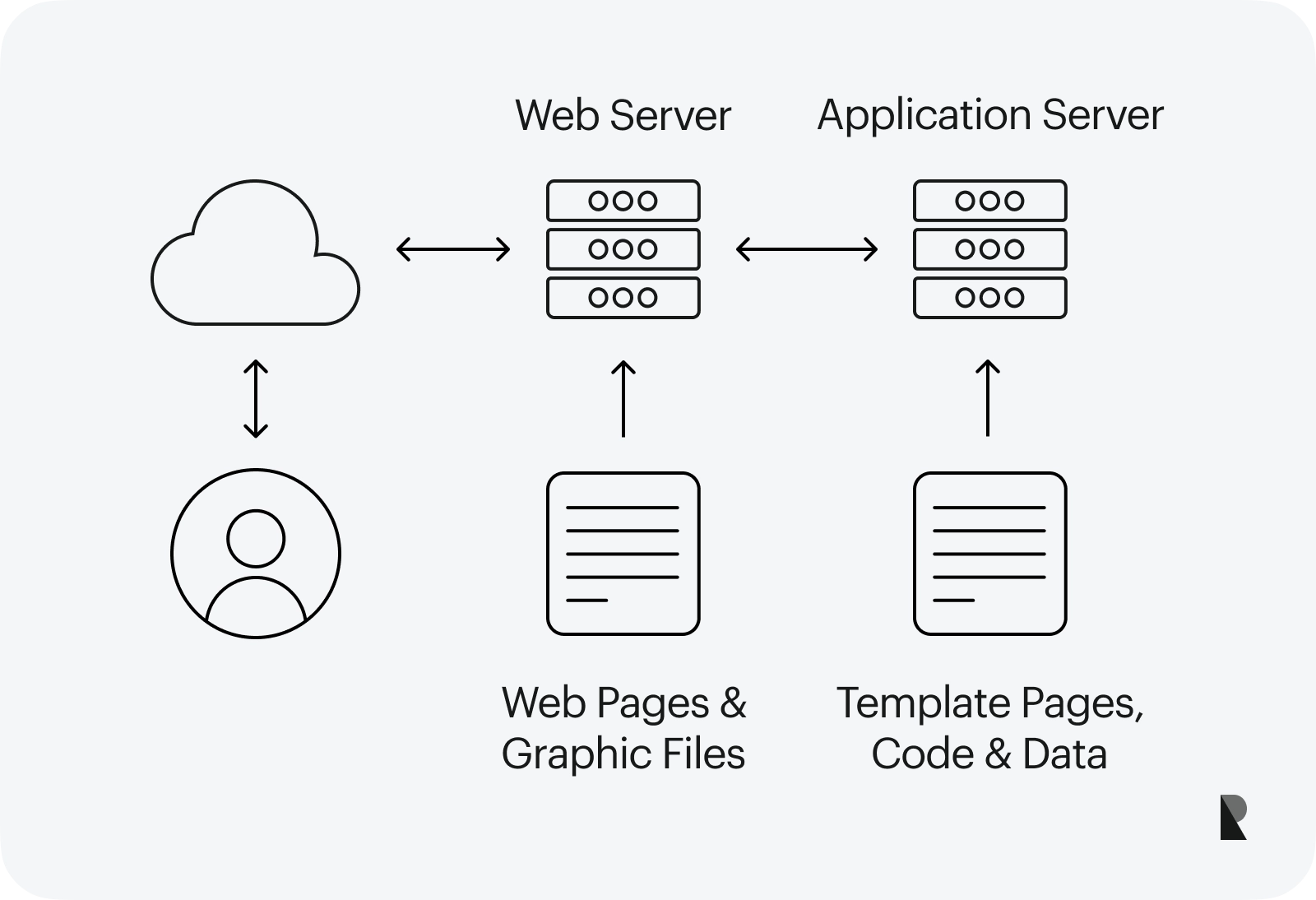
Difference between a web server and an application server at a glance
A web server primarily stores and delivers static content to create the final web pages. An application server, on the other hand, handles management beyond static content. It handles complex business logic and functionalities to create dynamic web experiences.
Below is a summarized overview of the major differences in web and application server functionalities and use cases.
| Feature | Web Server | Application Server |
|---|---|---|
| Core Function | Delivers static content (HTML, images, videos) | Handles complex business logic and application functionalities |
| Content Handling | Primarily static content, limited dynamic content with CGI | Dynamic content generation using scripting languages (Java Servlets, PHP, ASP.NET) |
| Security Features | Basic access control lists | Advanced features like user authentication, authorization, and data encryption |
| Resource Consumption | Less resource-intensive | More resource-intensive |
| Management Complexity | Easier to set up and manage | More complex configuration and management |
| Ideal Use Cases | Simple websites, CDNs, low-traffic websites | Complex web applications, high-traffic websites, enterprise environments |
The table above briefly overviews the fundamental differences that define web and application servers.
Differences between static and dynamic web servers
A web server software handles all the content displayed on a web page. The content can be a fixed entity on the page, called static content, or it can change according to the audience, called dynamic content.
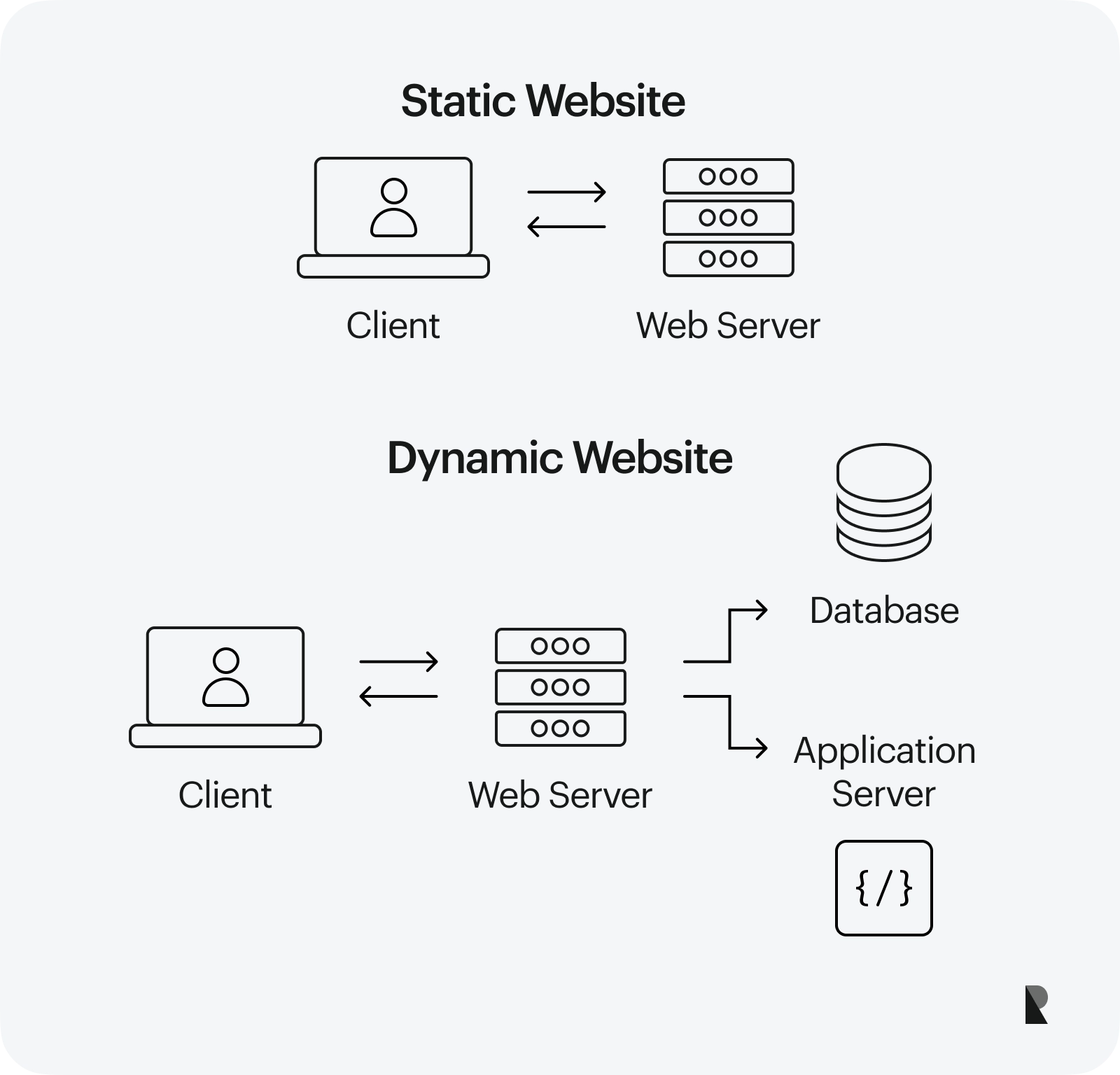
Differentiating between static and dynamic web servers
The information displayed on a web page is managed by dynamic or static web servers. The main difference lies in the flexibility of the content displayed and its interactivity for users. Below is a detailed comparison of the dynamic and static web servers.
| Feature | Static Web Server | Dynamic Web Server |
|---|---|---|
| Content Handling | Stores and delivers pre-defined content (HTML, images, videos) | Generates content dynamically using server-side scripting languages |
| Content Flexibility | Content remains the same for all users | Content can be personalized or adapted based on user input or situation |
| Interactivity | Limited interactivity (no forms, logins, dynamic updates) | High interactivity (forms, logins, shopping carts, real-time updates) |
| Setup and Management | Simpler setup and management | More complex setup and management |
| Ideal Use Cases | Simple websites (portfolios, brochures, landing pages), CDN content delivery | Complex web applications (social media, online stores, banking) |
| Analogy | Vending machine | Interactive restaurant |
Popular web server software
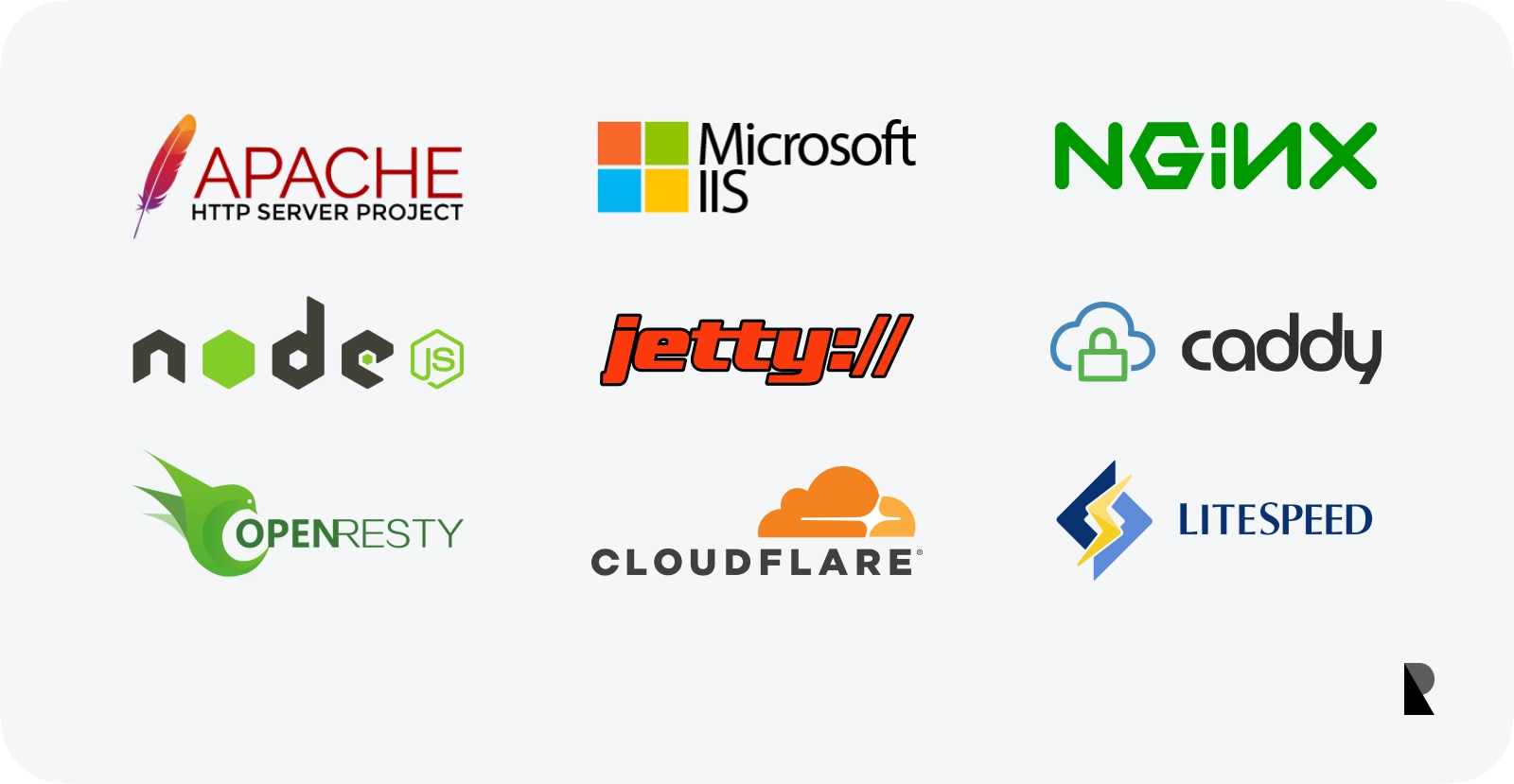
Building a web app requires the right web server. Hence, choosing an appropriate option is crucial for your website’s performance and customers’ experience.
The right choice will ensure that your web pages operate smoothly on a web browser with optimal performance.
Let’s look at some of the common choices in the market when selecting a web server.
What are the popular web servers in the market?
The most common web servers used in the market include:
- Apache HTTP server
- Microsoft internet information services
- Nginx
- LiteSpeed web server
Apache HTTP server
Apache is a popular option as it is free and open source, making it cost-effective and widely supported. It also offers extensive customization options for specific needs. The web server can also run on various operating systems.
Its popularity is also due to its focus on security practices. Its open-source web server position also leads its users to a large community for assistance. The only challenge is that it requires extensive configuration, making it a daunting choice for beginners.
Microsoft Internet Information Services (IIS)
Microsoft Internet Information Services (IIS) is specifically designed for Windows users. It integrates seamlessly with other Microsoft server products, making it a natural choice for people who have invested in the Windows ecosystem.
IIS servers deliver useful features for managing websites, applications, and other server tasks. They also leverage Active Directory for user authentication and authorization, but as proprietary software, they require a licensing fee. Another challenge is their limited use outside the Windows environment, leading to limited community support.
Nginx
Nginx is particularly useful in high-traffic environments. Its efficient architecture allows it to handle a large number of concurrent connections smoothly, making it ideal for busy websites. It also excels at reverse proxying and load balancing to distribute traffic effectively.
These features enable Nginx to operate traffic across multiple servers, offering better performance and scalability. Its lightweight design requires less memory compared to other options.
LiteSpeed web server (LSWS)
LiteSpeed Web Server (LSWS) is a smart choice if you want to boost your web server’s performance, especially when handling dynamic content. While its paid options offer additional features and support, an open-source version is also available.
Security is also essential to the server configuration with built-in features like mod_security integration. Hence, the market base for LSWS is similar to the target audience for Apache and Nginx, making it essential to consider all aspects when making a choice.
Hence, choosing the right web server is dependent on your priorities and needs. While Nginx is a useful choice for people new to server management, Apache or LSWS are more suitable for high-traffic websites.
While you navigate the many options in the market, consider factors like traffic volume, desired features, budget, and technical expertise to make an informed decision.
Web server security
Due to the critical role of web servers, they are prone to external malicious attacks. It puts your organization’s data at risk and threatens any competitive advantage you have in the market. Hence, it is equally important to take the necessary steps to ensure web server security.
Some actionable steps to protect your server and, subsequently, your web applications include:
1. Regular software updates
To stay ahead of attackers, ensure prompt execution of security updates for your web server software, operating system, and any applications. Consider scheduling automatic updates for continuous protection.
2. Strengthen server configuration
It is important to strengthen your server configuration. You can do this by disabling unused services, enforcing strong passwords with two-factor authentication, restricting access through control lists, and using secure protocols like SSH with strong key authentication for remote access.
3. Implement necessary security measures.
You must use a layered security approach by installing a firewall to filter traffic, adding a web application firewall (WAF) for targeted protection, and monitoring traffic to potentially block ongoing attacks.
4. Protect against common threats.
Enhance your security by protecting against common attacks. You can validate user input to prevent SQL injection and XSS. DDoS protection must be used against denial-of-service attacks. You must also install up-to-date antivirus and anti-malware software.
5. Maintain regular backups
If you regularly back up website files, databases, and server configurations, you are securely storing them offsite. Remember to test your backups regularly as well to guarantee successful restoration when needed.
6. Cloud observability
It offers centralized monitoring with real-time insights and anomaly detection. In case of any issues, it also ensures access to log analysis and a streamlined incident response. Such a holistic view ensures faster threat detection with an improved security infrastructure.
Thus, you can implement these security measures to ensure web server security. It ensures that your data is protected and that your customers can easily interact with your online web pages without threatening their privacy.
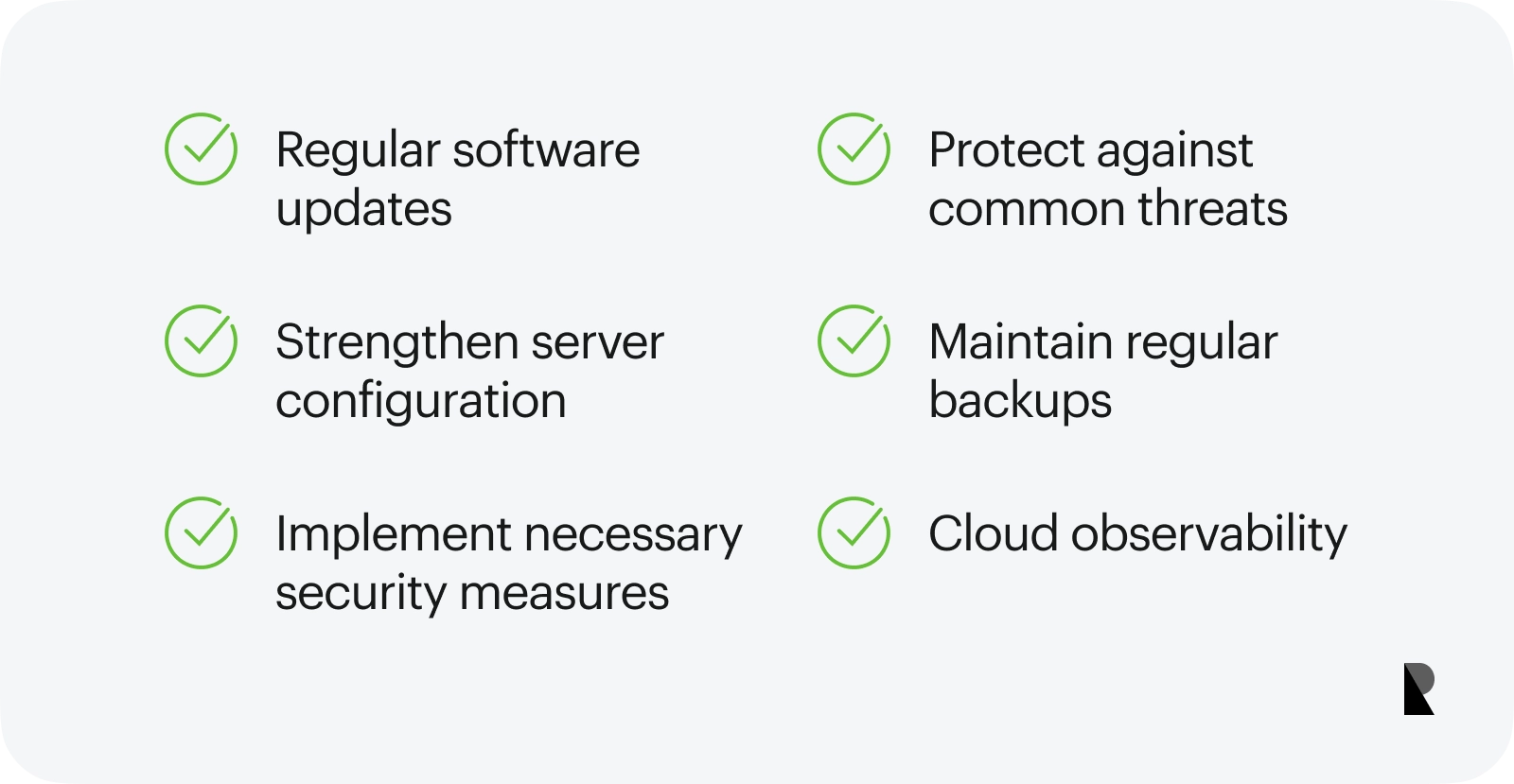
Conclusion
In modern digital infrastructure, web servers are central to powering online experiences. We have explored the many aspects of web servers, highlighting their importance and navigating how they function.
Exploring the differences between web servers and application servers also contributes to a better understanding of the concept, empowering businesses to make more informed decisions.
We have also delved deeper into understanding the difference between static and dynamic web content, providing insights into enterprises' web content options.
Finally, our blog explored actionable security tips and their valuable role in ensuring web server security. Keeping all these ideas in mind, you can explore the different web server options in the market to choose the right one for your business.
Web Server FAQ
How does a web server manage high-traffic volumes?
To handle high traffic, web servers leverage powerful hardware, traffic distribution (load balancing), cached content for faster delivery, and efficient server software for smooth operation under heavy loads.
What are the scalability options for web servers?
The options include vertical scaling (upgrading hardware on a single server) or horizontal scaling (adding more servers and distributing workload). Choosing the right method depends on traffic volume, budget, and technical expertise.
How do web server clusters work?
Web server clusters share a single IP address. A load balancer distributes requests and ensures high availability by having backup servers take over if one fails. It provides smooth scalability as your website grows.
What protocols do web servers primarily use?
Web servers rely on a two-protocol handshake: HTTP, the language for requesting and delivering web content (like webpages and images), and TCP, the reliable courier that ensures data gets delivered accurately between browsers and servers.
How does server-side caching enhance web server performance?
Server-side caching enhances web server performance by storing frequently accessed content. This reduces server load, enabling faster delivery and improved scalability to handle more users.
May 31, 2024
